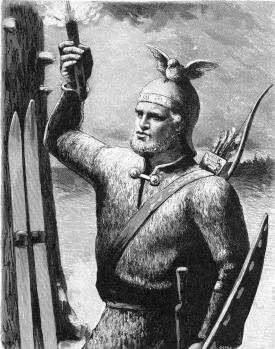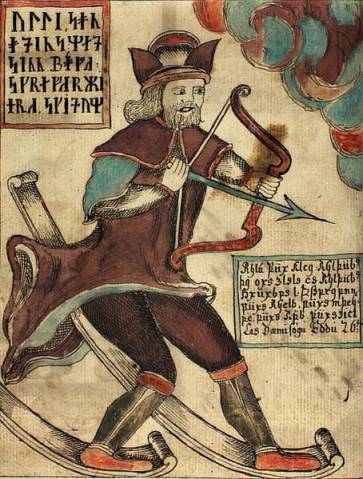Among the many Aesir and Vanir gods of Norse mythology, Ullr stands out as a somewhat enigmatic figure. While not as renowned as Odin or Thor, Ullr’s story is intriguing. Furthermore, he is bridging the beliefs of the pre-Viking Age with what we today know as Norse mythology.
Also, more personally, Ullr is easily my favorite among the Norse gods. I happen to live in an area of Oslo named Ullevaal, which stems from Ullarhváll (“Ullr’s hill”). At the top of the little hill we literally live on, is a number of Viking Age burial mounds. This connection to the Old Norse myths and Viking Age beliefs is endlessly fascinating to me.
Ullr Key Facts
| Parents | Sif (step-son of Thor) |
| Partners | Unknown |
| Siblings | Half-brother of Thrudr |
| Offspring | None known |
| Tribe | Aesir |
| Old Norse name | Ullr |
| Other names | Ull, Oller |
| The God of | Skiing, Archery, Oaths |
| Ass. Animal | Yew tree (associated with bows) |
Name and Etymology
Ullr, also known as Oller and Ull, is believed to be derived from the Proto-Germanic (PGmc) form reconstructed as *Wulþuz, which translates to ‘Glory’. This etymology is further supported by the compound owlþu-þewaz, found on the Thorsberg chape from the 3rd century AD.
This compound can be interpreted in two ways: as ‘servant of Owlþuz’ (if viewed as a theonym) or ‘who has glorious servants’ (if seen as an adjective). This name is a cognate of the Gothic noun wulþus, which means ‘glory’ or ‘wealth’. Both these terms trace their origins back to the Proto-Indo-European (PIE) noun *wul-tus, meaning ‘sight, gaze, or appearance’, which is derived from the root *wel-, signifying ‘to see’.
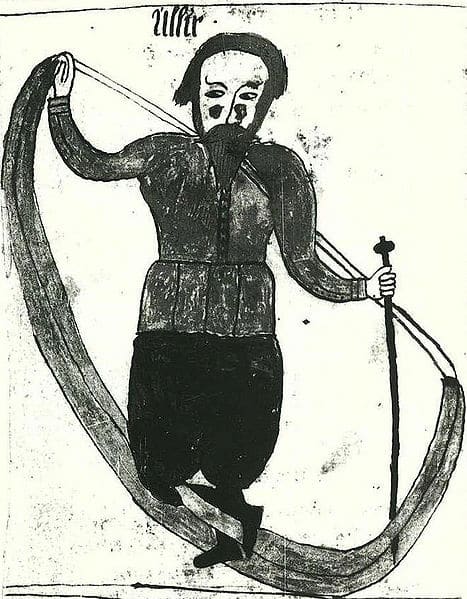
Kennings in Skáldskaparmál
Kennings are a unique feature of Old Norse poetry, where poets would use metaphorical phrases to describe or allude to something indirectly. In the Skáldskaparmál, a section of the Prose Edda, several kennings are associated with Ullr, shedding light on his various attributes and roles:
- Son of Sif
- Stepson of Thor
- God of the Snowshoe
- God of the Bow
- Hunting-God
- God of the Shield
Each of these kennings offers a glimpse into Ullr’s identity and significance in Norse mythology. For instance, referring to him as the “God of the Snowshoe” emphasizes his mastery over winter terrains, while “God of the Bow” underscores his unparalleled archery skills. Archery was a highly regarded skill both for hunting and in combat. I recenlty wrote a whole post on Viking Age weapons where you can learn about their different weapons.
A god with ancient roots
While Ullr’s presence is prominent in Norse mythology, traces of his name and characteristics can be found in older Germanic traditions, long before the Viking Age. The Thorsberg chape, mentioned above, provides tangible evidence of Ullr’s ancient legacy. The compound owlþu-þewaz inscribed on it hints at a reverence or association with a deity of ‘glory’ or ‘appearance’, which aligns with Ullr’s etymology.
Furthermore, there’s an intriguing association with Ullin, a possible female counterpart to Ullr from pre-Viking times. While Ullin isn’t one of Ullr’s known names in Norse mythology, the connection suggests that Ullr’s mythos might have evolved over time, incorporating elements from older traditions and possibly even gender dynamics. This association with Ullin adds another layer of depth to Ullr’s story, hinting at a rich tapestry of beliefs and tales that predate the Norse myths we’re more familiar with.
Ullr Origins
Ullr’s parentage is a topic of some debate among scholars. It’s largely understood that his mother is Sif. However, Thor is always mentioned as his step-father, or Ullr as a stepson of Thor, leaving his real father unnamed.
Despite this ambiguity, Ullr’s association with the Aesir tribe is clear. He is the half-brother of Thrudr, daughter to Thor and Sif who is a goddess and/or a Valkyrie.
There isn’t much information about Ullr’s birth or early life. What’s evident is that he grew up among the gods of Asgard, earning respect and admiration for his skills in archery and skiing.
Ullr Family and Relationships
Ullr’s relationships, especially romantic ones, remain shrouded in mystery. The ancient texts don’t provide much insight into his personal life. However, his bond with his mother, Sif, is undeniable, and he’s often depicted alongside her in various tales.
While Ullr is not known to have had a wife or children in the Norse myths we’re familiar with, there’s an intriguing association with Ullin from before the Viking Age. Ullin, a possible female counterpart or partner to Ullr, suggests that there might have been deeper connections and relationships in Ullr’s ancient past. This association with Ullin hints at a rich tapestry of beliefs and tales that predate the Norse myths, reminding us that just because certain details aren’t present in the texts we have today doesn’t mean they didn’t exist in the past.
Ullr Roles And Responsibilities
Ullr’s significance in Norse mythology is multifaceted. As the god of skiing and archery, he held a special place in the hearts of the Norse people. In a land where snow was a constant companion for a significant part of the year, skiing was more than just a recreational activity; it was a lifeline. Ullr’s mastery over skiing, ensuring safe passage over treacherous terrains, made him an indispensable deity.
His prowess in archery further elevated his status. In battles and skirmishes, Ullr’s unparalleled archery skills were legendary, making him a force to be reckoned with among both gods and mortals.
Ullr’s Tenure as the Guardian of Asgard
Among the pantheon of Norse gods, Ullr held a unique position. During a period when Odin, the Allfather, was exiled, Ullr was entrusted with the responsibility of overseeing Asgard. This ten-year guardianship, as documented by the Danish historian Saxo Grammaticus in his work “History of the Danes,” is a testament to Ullr’s integrity, strength, and the respect he garnered among the gods. While this narrative isn’t widely mentioned in other sources, its absence doesn’t negate its authenticity. Many tales and stories from the past have been lost to time, and this might be one such tale.
Ullr and Oath Rings
Ullr’s association with truth and integrity extended to the realm of humans as well. Invoking his name during oaths was a common practice, emphasizing his role as a guardian of promises and commitments. The discovery of Lilla Ullevi, a preserved shrine north of Stockholm, further cements this association. The shrine, with its beautifully preserved wooden and stone structures, also had 65 oath rings of varying sizes scattered around, suggesting that it was a significant site for oath-taking ceremonies in honor of Ullr.
Ullr: The Warrior God
The Thorsberg chape, dating back to around 200 CE, offers a glimpse into Ullr’s ancient warrior aspect. The inscription “Owlþuþewaz niwajmariz” can be translated as “Well honoured servant of the Glorious One,” or more specifically, “Servant (or priest) of Ullr.” This chape, a metal fitting from a sword scabbard, is among the oldest mentions of Ullr, highlighting his long-standing association with warfare and honor.
In conclusion, Ullr’s roles and responsibilities in Norse mythology were vast and varied. From overseeing Asgard in Odin’s absence to being a symbol of truth and integrity among humans, Ullr’s influence was both profound and pervasive.
Depiction And Characteristics
Ullr stands as a unique figure in Norse mythology, often depicted as a master archer with deep ties to the winter elements. His association with the bow is not just symbolic of his combat prowess but also connects him to the natural world, particularly the yew tree. The name Ýdalir, which translates to “yew dales”, further emphasizes this connection. Yew trees, essential for crafting bows, were important in Norse culture, and Ullr’s association with them underscores his mastery in archery.
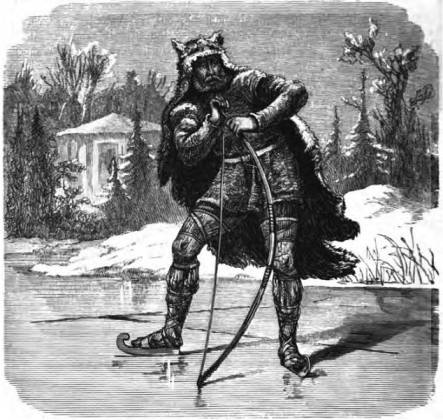
His calm and composed demeanor sets him apart from other more boisterous Norse gods. While he might not be as frequently mentioned as Odin or Thor, Ullr’s tales often highlight his unwavering sense of duty, honor, and his deep-rooted connection to the natural world, especially the snowy landscapes of Scandinavia.
Ullr and the Art of Skiing
Ullr’s profound association with skiing is a defining characteristic in Norse mythology. While the origins of skiing are ancient and widespread, Ullr’s connection to this winter sport is deeply rooted in the cultural and religious practices of ancient Scandinavian communities. The name Ýdalir, meaning “yew dales”, is intricately connected with Ullr. The yew tree, essential for crafting bows, hints at Ullr’s prowess in archery. This connection between Ullr and bows suggests a profound relationship with skiing, as the act of skiing, much like archery, requires precision, balance, and a deep understanding of the environment.
However, Ullr isn’t the only deity in Norse mythology associated with skiing. Skadi, a giantess and goddess, is also closely linked to skiing and winter. Skadi’s love for the mountains and winter landscapes is well-documented in Norse myths. Her association with skiing, much like Ullr’s, underscores the importance of this activity in the daily lives and cultural practices of the Norse people. The reverence for these deities might have been a reflection of the communities’ respect for the harsh winter landscapes they inhabited and the activities that helped them navigate these terrains.
Ullr Symbols, Artifacts, and Animals
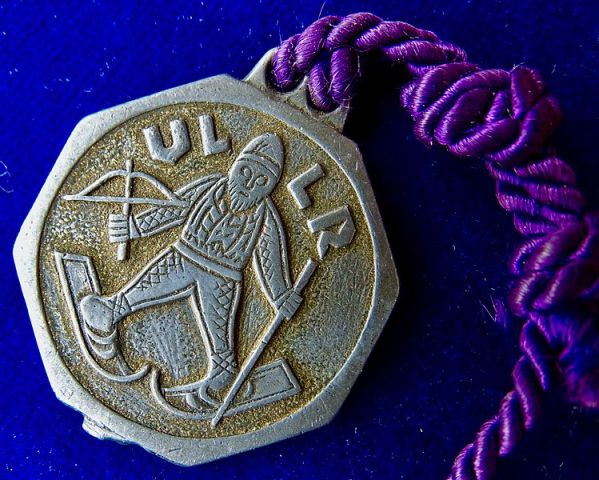
Ullr’s significance is reflected both in his roles as well as in the symbols and artifacts associated with him. These symbols provide a deeper understanding of his influence and the reverence he commanded among both gods and mortals.
The Bow and Yew Tree
Ullr’s primary symbol is his bow, a testament to his unparalleled skills in archery. The yew tree, essential for crafting bows, is intricately linked with Ullr. The name Ýdalir, meaning “yew dales”, further emphasizes this connection. The yew tree’s association with archery and its use in crafting bows is well-documented, underscoring Ullr’s deep connection to archery and the natural world.
Oath Rings
One of the most profound symbols associated with Ullr is the oath ring. For mortals, invoking Ullr’s name while taking oaths was a common practice, emphasizing his role as a guardian of promises and commitments. The discovery of Lilla Ullevi, a preserved shrine north of Stockholm, further cements this association. The shrine, with its beautifully preserved wooden and stone structures, also had 65 oath rings of varying sizes scattered around. These rings, used during oath-taking ceremonies, are a tangible testament to Ullr’s association with truth, integrity, and the sacred bond of promises.
Skis
Ullr’s association with skiing is also symbolically significant. As the god of skiing, he embodies the spirit of winter and the freedom of gliding over snowy terrains. Skis, for the Norse people, were not just tools but symbols of survival, agility, and harmony with nature.
Play Fun Norse Quiz
Is this article making you even more curious about Norse gods and goddesses? You can satisfy your curiosity by playing a fun Norse mythology quiz. This way, you can test your knowledge about Norse gods and goddesses, as well as fill in some gaps. Good luck and have fun playing!
Don’t forget to try our other games as well!
Myths about Ullr
The Norse pantheon is replete with tales of heroism, treachery, love, and war. However, when it comes to Ullr, the god of skiing and archery, the tapestry of myths is surprisingly sparse. This scarcity is intriguing, especially given Ullr’s evident significance in various ancient texts and his revered status among the gods and mortals.
Ullr’s Tenure as the Guardian of Asgard
One of the few myths that prominently feature Ullr is the tale of his guardianship over Asgard. According to the narrative, during a period of exile imposed upon Odin, Ullr was chosen to take his place. This wasn’t a mere placeholder role; Ullr assumed full sovereignty over Asgard, overseeing the realm of the gods.
This story, as documented by the Danish historian Saxo Grammaticus in his work “Gesta Danorum,” paints a picture of Ullr’s character. To be chosen to rule Asgard in Odin’s stead speaks volumes about Ullr’s integrity, strength, and the respect he garnered among the gods. For ten years, Ullr ruled, ensuring the stability and prosperity of Asgard until Odin’s return.
“When Odin was exiled, Ollerus was chosen to take his place and ruled under the name Odin for ten years until the true Odin was called back.”
The Lost Myths of Ullr
The story of Ullr’s guardianship over Asgard stands out not just for its content but also for its rarity. It’s puzzling that a god of Ullr’s stature, with evident significance in rituals, oath-taking, and daily life, has so few myths to his name.
It’s possible that many tales involving Ullr were lost over time. Norse myths were primarily passed down orally, and only a fraction of these stories were eventually committed to writing. Over centuries, tales could have been forgotten, altered, or simply not recorded. The absence of myths doesn’t negate Ullr’s importance. Instead it underscores the transient nature of oral traditions and the gaps in our understanding of Norse mythology.
Mentions in Ancient Texts
Ullr’s presence in ancient texts provides a comprehensive understanding of his significance and roles in Norse mythology. These mentions offer insights into his character, responsibilities, and the reverence he commanded among both gods and mortals.
Prose Edda
Gylfaginning
In the Gylfaginning chapter of the Prose Edda, written by Snorri Sturluson in the 13th century, Ullr is introduced as the son of Sif and the stepson of Thor. His prowess in archery and skiing is highlighted, emphasizing his unmatched skills in these domains. The text reads:
“Ullr, Sif’s son and Thór’s stepson, is one [too]. He is such a good archer and ski-runner that no one can rival him. He is beautiful to look at as well and he has all the characteristics of a warrior. It is also good to call on him in duels.” – Young’s translation
Skáldskaparmál
In the Skáldskaparmál section, Ullr’s various kennings are listed, including references to him as the ski-god, bow-god, hunting-god, and shield-god. The shield, in particular, is metaphorically referred to as “Ullr’s ship.” Despite these detailed kennings, Snorri does not delve into specific myths about Ullr. This might be due to a lack of knowledge or the absence of such tales in his sources.
Poetic Edda
Grímnismál
In the Grímnismál poem of the Poetic Edda, Ullr’s home, Ýdalir, is mentioned, emphasizing his connection to the yew tree, a vital material for crafting bows. The poem states:
“Ýdalir it is called, where Ullr has himself a dwelling made.”
Another strophe in the same poem hints at a religious ceremony associated with Ullr, suggesting his importance in such rituals.
Atlakviða
The Atlakviða poem references Ullr in the context of oath-taking, further underscoring his association with truth and integrity. The poem reads:
“So be it with thee, Atli! as toward Gunnar thou hast held the oft-sworn oaths, formerly taken – by the southward verging sun, and by Sigtý’s hill, the secluded bed of rest, and by Ullr’s ring.”
Gesta Danorum
In Saxo Grammaticus’ 12th-century work Gesta Danorum, Ullr, referred to as Ollerus, is depicted as a cunning wizard with magical means of transportation. The text reads:
“The story goes that he was such a cunning wizard that he used a certain bone (probably a sledge or similar conveyance), which he had marked with awful spells, wherewith to cross the seas, instead of a vessel; and that by this bone he passed over the waters that barred his way as quickly as by rowing.” – Elton’s translation
This work also highlights Ullr’s tenure as the guardian of Asgard during Odin’s exile, emphasizing his importance and the trust he commanded among the gods.
Skaldic poetry
Skaldic poems, including Haustlöng, Eilífr Goðrúnarson’s Þórsdrápa, and a fragment by Eysteinn Valdason, reiterate the relationship between Ullr and Thor, with Thor being Ullr’s stepfather. These poems, along with various kennings, further emphasize Ullr’s association with warfare, archery, and skiing.
Frequently Asked Questions
Ullr is revered as the god of skiing and archery, and his name is often invoked during oaths.
Ullr’s mother is Sif, and while some believe Thor is his father, it’s not universally accepted.
Yes, Ullr is mentioned in both the Poetic Edda and the Prose Edda, ancient texts that chronicle Norse myths.
There are no known offspring of Ullr mentioned in the ancient texts.
Ullr’s primary weapon is his yew bow, symbolizing his mastery over archery.
Featured Image Credit: Olaus Magnus, Public domain, via Wikimedia Commons

